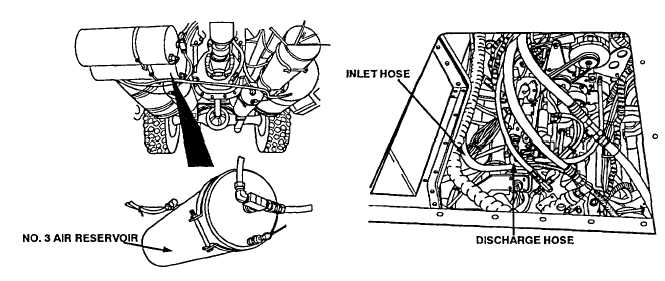|
| |
TM 9-2320-360-20-1
AIR COMPRESSOR TEST
(1)
Drain air system (TM 9-2320-360-10).
(2)
Remove drain plug from no. 3 air tank.
WARNING
Air compressor discharge hose no. 2001 gets extremely hot during normal
air compressor operation. Allow sufficient time for hose to cool before
performing inspection. Failure to comply may result in injury to personnel.
(3)
Remove air compressor discharge hose no. 2001 and inlet hose no. 2600 from air compressor.
(4)
Start engine (TM 9-2320-360-10).
(5)
Operate engine at 2100 RPM for five minutes to bring air compressor up to operating temperature.
(6)
Reduce engine speed to 1800 RPM and maintain that speed.
WARNING
Use extreme care while holding cardboard when engine is running. Rotating
engine accessories and hot engine parts may cause injury.
(7)
Hold a 5 in. x 10 in. (12.7 cm x 25.4 cm) piece of cardboard 1 in. (2.54 cm) from the discharge port
for 1 minute.
(8)
Shut off engine (TM 9-2320-360-10).
(9)
Compare cardboard to the following:
a. No oil spot- compressor OK
b. Oil spot 2 in. (5 cm) or less, splatter off to one side, or light splatter - compressor OK
c. 011 spot greater than 2 in. (5 cm) and/or heavy splatter - compressor faulty
(10) Install air compressor discharge hose no. 2001 and inlet hose no. 2600 on air compressor.
WARNING
Pipe thread sealing compound can burn easily, can give off harmful vapors,
and is harmful to skin and clothing. To avoid injury or death, keep
compound away from open fire and use in well-ventilated area. If pipe
thread sealing compound gets on skin or clothing, wash immediately with
soap and water.
CAUTION
Use pipe thread sealing compound sparingly, only on pipe threads Do not apply
compound at hose connections. Failure to comply may result in component
damage.
(11) Coat threads of drain plug with pipe thread sealing compound.
(12) Install drain plug in no. 3 air tank.
2-757
|

